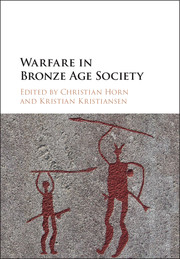Book contents
- Warfare in Bronze Age Society
- Warfare in Bronze Age Society
- Copyright page
- Contents
- Contributors
- Preface
- Chapter One Introducing Bronze Age Warfare
- Chapter Two Bronze Age Encounters: Violent or Peaceful?
- Chapter Three Warfare and the Political Economy: Europe 1500–1100 bc
- Chapter Four Warfare vs. Exchange? Thoughts on an Integrative Approach
- Chapter Five Maritime Warfare in Scandinavian Rock Art
- Chapter Six Bronze Weaponry and Cultural Mobility in Late Bronze Age Southeast Europe
- Chapter Seven The Emergence of Specialized Combat Weapons in the Levantine Bronze Age
- Chapter Eight Beyond the Grave: Crafting Identities in the Middle Bronze Age Southern Trans Urals
- Chapter Nine Carp’s-Tongue Swords and Their Use: Functional, Technological and Morphological Aspects
- Chapter Ten Warfare or Sacrifice? Archaeological Research on the Bronze Age Site in the Tollense Valley, Northeast Germany
- Chapter Eleven Violence and Ritual in Late Bronze Age Britain: Weapon Depositions and Their Interpretation
- Chapter Twelve ‘Warrior Graves’ vs. Warrior Graves in the Bronze Age Aegean
- Chapter Thirteen The Chief and His Sword? Some Thoughts on the Swordbearer’s Rank in the Early Nordic Bronze Age
- Chapter Fourteen Becoming the Warrior: Constructed Identity or Functional Identity?
- Chapter Fifteen Body Aesthetics, Fraternity and Warfare in the Long European Bronze Age: Postscriptum
- Index
- References
Chapter Thirteen - The Chief and His Sword? Some Thoughts on the Swordbearer’s Rank in the Early Nordic Bronze Age
Published online by Cambridge University Press: 06 April 2018
- Warfare in Bronze Age Society
- Warfare in Bronze Age Society
- Copyright page
- Contents
- Contributors
- Preface
- Chapter One Introducing Bronze Age Warfare
- Chapter Two Bronze Age Encounters: Violent or Peaceful?
- Chapter Three Warfare and the Political Economy: Europe 1500–1100 bc
- Chapter Four Warfare vs. Exchange? Thoughts on an Integrative Approach
- Chapter Five Maritime Warfare in Scandinavian Rock Art
- Chapter Six Bronze Weaponry and Cultural Mobility in Late Bronze Age Southeast Europe
- Chapter Seven The Emergence of Specialized Combat Weapons in the Levantine Bronze Age
- Chapter Eight Beyond the Grave: Crafting Identities in the Middle Bronze Age Southern Trans Urals
- Chapter Nine Carp’s-Tongue Swords and Their Use: Functional, Technological and Morphological Aspects
- Chapter Ten Warfare or Sacrifice? Archaeological Research on the Bronze Age Site in the Tollense Valley, Northeast Germany
- Chapter Eleven Violence and Ritual in Late Bronze Age Britain: Weapon Depositions and Their Interpretation
- Chapter Twelve ‘Warrior Graves’ vs. Warrior Graves in the Bronze Age Aegean
- Chapter Thirteen The Chief and His Sword? Some Thoughts on the Swordbearer’s Rank in the Early Nordic Bronze Age
- Chapter Fourteen Becoming the Warrior: Constructed Identity or Functional Identity?
- Chapter Fifteen Body Aesthetics, Fraternity and Warfare in the Long European Bronze Age: Postscriptum
- Index
- References
Summary
- Type
- Chapter
- Information
- Warfare in Bronze Age Society , pp. 198 - 212Publisher: Cambridge University PressPrint publication year: 2018
References
- 7
- Cited by

